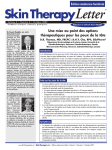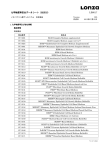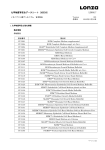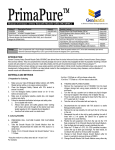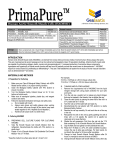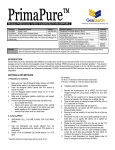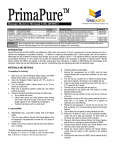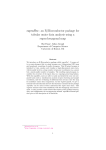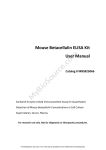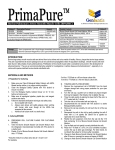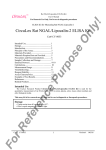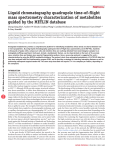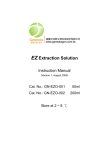Download PH10005X HMVEC Manual
Transcript
Human Dermal Microvascular Endothelial Cells (HMVEC) Catalog # Description/Content Amount PH10005A HMVEC, Adult >500,000 cells PH10005N HMVEC, Neonatal >500,000 cells PH10005AK HMVEC, Adult Complete System 1 Kit* PH10005NK HMVEC, Neonatal Complete System 1 Kit* *Each kit contains an ampoule of cryopreserved HMVEC (PH10005A or PH10005N), 500 ml of HMVEC Cell Growth Medium (PM112500), a Subculture Reagent Kit (PR090100K), two Extracellular Matrix Protein Coated T-25 flasks (PR121252), and Attachment Factor Solution (PR123100). Storage: A division of Gene Therapy Systems, Inc. Related Products HMVEC Growth Medium, 500 ml HEPES Buffered Saline Solution (HBSS), 100 ml Trpsin/EDTA, 100 ml Trypsin Neutralizing Solution, 100 ml Subculture Reagent Kit, including100 ml each of HBSS, Trpsin/EDTA, and Trpsin Neutralizing Solution Extracellular Matrix Protein Coated T-25 Flasks, 2 each Attachment Factor Solution, 100 ml GenePORTER 2 Transfection Reagent, 0.75 ml Catalog # PM112500 PR062100 PR070100 PR080100 PR090100K PR121252 PR123100 T202007 Store cryopreserved vials in liquid nitrogen immediately upon arrival. Store the growth medium at 4°C in the dark immediately upon arrival. Store the Subculture Reagent Kit at -20°C upon arrival and store the reagents at 4°C upon thawing. Store all other components at 4°C. INTRODUCTION HMVEC are isolated from normal human neonatal foreskin or adult skin capillaries. They are cryopreserved at second passage and can be cultured and propagated at least 16 population doublings. They are responsive to cytokine stimulation in the expression of cell adhesion molecules. HMVEC express CD36 constitutively, while large vessel endothelial cells do not. HMVEC is an organ-specific endothelial cell system for the study of angiogenesis1, tumor metastasis2,3, wound healing4, inflammation5,6, macromolecule transport7, and drug metabolism8. There is growing evidence of differences in physiology and pharmacology between microvascular endothelial cells and macrovascular endothelial cells9,10. MATERIALS AND METHO 5 cm2. For example, 5-7.5 ml for a T-25 flask or a 60 mm tissue culture dish. 15 ml for a T-75 flask or a 100 mm tissue culture dish. I. Preparation for Culturing 1. 2. 3. 4. 5. Make sure your Class II Biological Safety Cabinet, with HEPA filtered laminar airflow, is in proper working condition. Clean the Biological Safety Cabinet with 70% alcohol to ensure it is sterile. Turn the Biological Safety Cabinet blower on for 10 min. before cell culture work. Make sure all serological pipettes, pipette tips, and reagent solutions are sterile. Follow the standard sterilization technique and safety rules: a. Do not pipette with mouth. b. Always wear gloves and safety glasses when working with human cells even though all the strains have been tested negative for HIV, Hepatitis B and Hepatitis C. c. Handle all cell culture work in a sterile hood. II. Culturing HDF Cells A. PREPARING CELL CULTURE FLASKS FOR CULTURING HMVEC 1. Take the Extracellular Matrix Protein Coated Flasks and HMVEC Growth Medium from the refrigerator. Decontaminate the bottle with 70% alcohol in a sterile hood. Prepare two pre-coated T-25 flasks for culturing HMVEC by pipetting 7.5 ml of HMVEC Growth Medium* to a T-25 flask. NOTE: Keep the medium to surface area ratio at 1-1.5 ml per 2. B. THAWING AND PLATING HMVEC Remove the cryopreserved vial of HMVEC from the liquid nitrogen storage tank using proper protection for your eyes and hands. 2. Turn the vial cap a quarter turn to release any liquid nitrogen that may be trapped in the threads, then re-tighten the cap. 3. Thaw the cells quickly by placing the lower half of the vial in a 37°C water bath for 1minute. 4. Take the vial out of the water bath and wipe dry. 5. Decontaminate the vial exterior with 70% alcohol in a sterile Biological Safety Cabinet. 6. Remove the vial cap carefully. Do not touch the rim of the cap or the vial. 7. Resuspend the cells in the vial by gently pipetting the cells 5 times with a 2 ml pipette. Be careful not to pipette too vigorously as to cause foaming. 8. Pipette 0.5 ml of the cell suspension from the vial into each T25 flask containing 7.5 ml of HMVEC Growth Medium. 9. Cap the flask and rock gently to evenly distribute the cells. 10. Place the T-25 flask in a 37oC, 5% CO2 humidified incubator. Loosen the cap to allow gas exchange. For best results, do not disturb the culture for 24 hours after inoculation. 11. Change to fresh HMVEC Growth Medium after 24 hours or 1. Human Dermal Microvascular Endothelial Cells (HMVEC) Manual culture dish. 7.5 ml for coating a T-75 flask or a 100mm culture dish overnight to remove all traces of DMSO. 12. Change HMVEC Growth Medium every other day until the cells reach 60% confluent. 13. Double the HMVEC Growth Medium volume when the culture is >60% confluent or for weekend feedings. 14. Subculture the cells when the HMVEC reach 80% confluent. . C. SUBCULTURING HMVEC III. Subculturing HDF Cells 1. 2. A. PREPARING SUBCULTURE REAGENTS 1. Remove the Subculture Reagent Kit from the -20°C freezer and thaw overnight in a refrigerator. Make sure all the subculture reagents are thawed. Swirl each bottle gently several times to form homogeneous solutions. Store all the subculture reagents at 4°C for future use. The activity of Trypsin/EDTA Solution will be stable for 2 weeks when stored at 4°C. Aliquot Trypsin/EDTA solution and store the unused portion at -20°C if only portion of the Trypsin/EDTA is needed. 2. 3. 4. B. PREPARING CULTURE FLASK 1. Swirl the Attachment Factor Solution bottle a few times to form a homogenous solution. If the solution is gelled, warm up in 56°C water bath for 10 minutes and swirl the bottle to mix the solution. Decontaminate the bottle with 70% alcohol in a sterile hood. Add 7.5 ml of Attachment Factor Solution* to a T-75 flask and rock the flask gently to distribute the solution evenly to cover the whole culture surface. Coat the culture ware for 30 minutes at 37°C or 2 hours (overnight is also okay) at room temperature. Remove the Attachment Factor Solution by aspiration in a sterile hood. The coated flask can be used immediately or stored at 4°C for up to one month. Prepare the coated flask for subculturing by pipetting 15 ml of HMVEC Growth Medium into this coated T-75 flask and wait for seeding. NOTE: The coating concentration is 1 ml per 10cm2 surface area of culture ware. 2.5 ml for coating a T-25 flask or a 60mm 2. 3. 4. 5. 6. 7. Trypsinize Cells at Room Temperature. Do Not Warm Any Reagents to 37°C. 3. 4. 5. 6. 7. 8. 9. 10. 11. 12. 13. 14. 15. Remove the medium from culture flasks by aspiration. Wash the monolayer of cells with HBSS and remove the solution by aspiration. Pipette 2.5 ml of Trypsin/EDTA Solution into the T-25 flask. Rock the flask gently to ensure the solution covers all the cells. Remove 1.5 ml of the solution immediately. Re-cap the flask tightly and monitor the trypsinization progress at room temperature under an inverted microscope. It usually takes about 1 minute for the cells to become rounded but still attached to the flask. (When rounded cells detach by itself without hitting, it means the cells are over trypsinized.) Release the rounded cells from the culture surface by hitting the side of the flask against your palm until most of the cells are detached. Pipette 5 ml of Trypsin Neutralizing Solution to the flask to inhibit further tryptic activity. Transfer the cell suspension from the flask to a 50 ml sterile conical tube. Rinse the flask with an additional 5 ml of Trypsin Neutralizing Solution and transfer the solution into the same conical tube. Examine the T-25 flask under a microscope. If there are >20% cells left in the flask, repeat Steps 2-9. Centrifuge the conical tube at 220 x g for 5 minutes to pellet the cells. Aspirate the supernatant from the tube without disturbing the cell pellet. Flick the tip of the conical tube with your finger to loosen the cell pellet. Resuspend the cells in 5 ml of HMVEC Growth Medium by gently pipetting the cells to break up the clumps. Count the cells with a hemocytometer or cell counter. Inoculate at 10,000 cells per cm2 for rapid growth, or at 6,000 cells per cm2 for regular subculturing. LICENSE REFERENCES 1. 2. 3. 4. 5. 6. 7. 8. 9. 10. Swerlick, R.A. et.al, J. Invest. Dermatol. 97(2):190 (1991). Folkman, J. et al, Nature 288:551 (1980). Lee, K.H. et al, J. Invest. Dermatol. 98(1):79 (1992). Deryugina, E.I. et al, Hybridoma 15(4):279 (1996). Sepp, N.T. et al, J. Invest. Dermatol. 104(2):277 (1995). Swerlick, R.A. et al, J. Invest. Dermatol. 100(1):111S (1993). Hanasaki, K. et al, J. Bio. Chem. 270(13):7533 (1995). Pruckler, J.M. et al, Pathobiology 61:283 (1993). Foster, C.A. et al, J. Dermatol. 21(11):847 (1994). Schnitzer, J.E. et al, BBRC. 199(1):11 (1994). The purchase price paid for the PrimaPure™ cells and reagents grants end users a nontransferable, non-exclusive license to use the kit and/or its components for internal research use only as described in this manual; in particular, research use only excludes and without limitation, resale, repackaging, or use for the making or selling of any commercial product or service without the written approval of Genlantis. Separate licenses are available for non-research use or applications. The PrimaPure™ cells and reagents are not to be used for human diagnostic or included/used in any drug intended for human use. Care and attention should be exercised in handling the product by following appropriate research lab practices. Purchasers may refuse this license by returning the enclosed materials unused. By keeping or using the enclosed materials, you agree to be bound by the terms of this license. The laws of the State of California shall govern the interpretation and enforcement of the terms of this license. Genlantis Page 2 of 2 10190 Telesis Court. San Diego, CA 92121 • Toll Free (888) 428-0558 • U.S. & Canada (858) 457-1919 • www.genlantis.com JL060514 2006 Gelantis and Gene Therapy Sytems, Inc.


